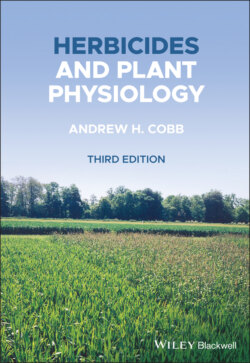Читать книгу Herbicides and Plant Physiology - Andrew H. Cobb - Страница 31
1.5.10 Vegetative reproduction
ОглавлениеNot all weeds classified as competitive ruderals are annuals. The exceptions are the herbaceous perennials, which have a high capacity for vegetative growth and include many of the most important weeds in the world. The vegetative production of new individuals can often be a very successful means of weed establishment. This is because the vegetative structures can rely on the parent plant for nutrients, which can confer a competitive advantage, especially at the start of the growth season. There are, however, disadvantages to vegetative reproduction. The principal ones are that since daughter plants are genetically identical to their parents, they may not be well adapted to a changing environment and that widespread dispersal cannot occur by vegetative means alone, unlike with seeds. The vegetative structures themselves include stolons, rhizomes, tubers, bulbs, corms, roots and turions.
Stolons are long, slender stems that grow along the soil surface to produce adventitious roots and shoots; examples include the perennial bermuda grass (Cynodon dactylon), the annual crabgrass (Digitaria sanguinalis) and creeping buttercup (Ranunculus repens). Rhizomes are underground stems from which adventitious roots and shoots arise. Major examples include the perennials Johnson grass (Sorghum halepense), couch grass (Elytrigia repens), perennial sedges such as purple and yellow nutsedge (Cyperus rotundus and C. esculentus) and ground elder (Aegopodium podagraria). Purple nutsedge (Cyperus rotundus) has an extensive underground system of rhizomes and tubers. The rhizomes can penetrate and pass completely through vegetable root crops, and the tubers can remain dormant and carry the plant through very extreme conditions of drought, flooding or lack of aeration. Cyperus rotundus is a major weed of tropical and warm temperate regions of sugar cane, rice, cotton, maize and vegetables, groundnuts, soybeans and sorghum. Japanese knotweed (Fallopia japonica), a highly invasive weed that has become a particular problem in many parts of the world, propagates largely by means of rhizomes (both locally and in moved soil; Figueroa, 1989), as colonies rarely result from seed.
Tubers are enlarged terminal portions of rhizomes that possess storage tissues and axillary buds. Examples include the perennial sedges mentioned above, Jerusalem artichoke (Helianthus tuberosus) and the common white potato (Solanum tuberosum). Another particularly troublesome weed that produces tubers is the horsetail (Equisetum arvense). In this case, aerial shoots can be easily controlled, but deep‐seated tubers will produce new shoots when conditions permit.
Bulbs are also underground organs that are modified buds surrounded by scale leaves, which contain the stored nutrients for growth, an example being wild onion (Allium vineale). Corms are swollen, vertical underground stems covered by leaf bases, for example, bulbous buttercup (Ranunculus bulbosus).
Many species produce long, creeping horizontal roots that give rise to new individuals, including perennial sow thistle (Sonchus arvensis), field bindweed (C. arvensis) and creeping or Canada thistle (Cirsium arvense). Some biennials and perennials form swollen, non‐creeping taproots capable of regenerating whole plants. Common examples are dandelion (Taraxacum officinale) and curled and broad‐leaved docks (Rumex crispus and R. obtusifolius). Several aquatic weeds produce vegetative buds or turions that have specialised nutrient‐storing leaves or scales. These separate from the parent plant in unfavourable conditions, or are released after the decay of the parent, to remain dormant until favourable conditions return. Examples include Canadian pondweed (Elodea canadensis) and Ceratophyllum demersum.
Cultivation and soil disturbance will promote the fragmentation of all these vegetative structures. Propagation will then occur when the vegetative structure is separated from the parent plant. The brittleness of leafy parts ensures that although leaves may be removed manually or by grazing, the means of vegetative reproduction remains in the soil. Only continuous cultivation will prevent the accumulation of stored nutrient reserves and so control these weeds.
